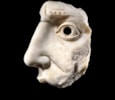Fragment of a Theatre Mask
Fragment of a Theatre Mask
Fragment of a Theatre Mask, Probably from an Oscillum
Circa 2nd Century A.D., Roman
Marble
H: 18.8 cm, W: 14.2 cm
Sold
A fragment from an over-lifesize Roman marble theatre mask, depicting the proper left side of the face, from the upper lip to just above the eyebrow. The large eye is framed by deeply scored eyelids, emphasising its wide-open gaze. The pupil is drilled through the mask, further suggesting an expression of great shock or horror. The is also conveyed by the furrowed eyebrow and frown lines carved at the top of the strong nose. At the base of the nose, deep nasolabial folds, and the curled-up lip add to the dramatic expression. This exaggerated facial expression is typical of ancient theatre masks, suggesting this fragment may have represented a dramatic character, probably from a tragedy.
In ancient Rome, theatre was generally separated into the comedic and tragic genres, building on the theatrical traditions of ancient Greece. Although no early Roman tragedy survives, historians know of three writers (Ennius, Pacuvius, and Lucius Accius) who were writing prior to the republican period. The earliest important works known today are those by Livius Andronicus and Gnaeus Naevius, both writing in the mid-3rd century B.C.. By the start of the 2nd century B.C., drama was a firmly established institute in Rome, and the collegium poetarum (writers guild) had been formed. Theatrical masks were used in both comedies and tragedies. Comedic masks were highly caricatured in style, tending towards grotesque features, while tragic masks were more realistic, though still with extremely exaggerated expressions. Masks were used to differentiate each of the characters, as well as to the emotional tone of the performance. It is believed that masks may have also helped to amplify the actor’s voices around the open-air theatre.
Although none of the masks worn by actors survive today, their appearance can be reconstructed through the numerous uses of the motif on decorative objects. Masks are recorded in wall mosaics, and on oil lamps, as well as carved in bas-relief on oscilla. Oscilla are small discs which were carved with small figures and suspended from ceilings or garden peristyles in Roman houses as offerings to the gods and as part of various festivals throughout the year. These discs swayed gently in the wind, leading to Latin word oscillare (to swing), and eventually to the English oscillation. It is likely that this fragment was originally part of an oscillum, which may have depicted this tragic mask alongside its comedic counterpart.
Colonnade: Antiquities, Islamic & Indian Art, Oriental Miniatures & Manuscripts, Sotheby’s, London, 28 April 1995, Lot 107.
Ancient Sculpture and Works of Art, Sotheby’s, London, 5 July 2024, Lot 153.
Previously in the Private Collection of Howard Hodgkin (1932-2017), London.
Thence by descent to his partner, Antony Peattie (b. 1953), London.
Sold at: Ancient Sculpture and Works of Art, Sotheby’s, London, 5 July 2024, Lot 153.
Paris art market, acquired from the above sale, accompanied by purchase invoice.
ALR: S00260463, with IADAA Certificate, this item has been checked against the Interpol database.










 Enquire
Enquire




